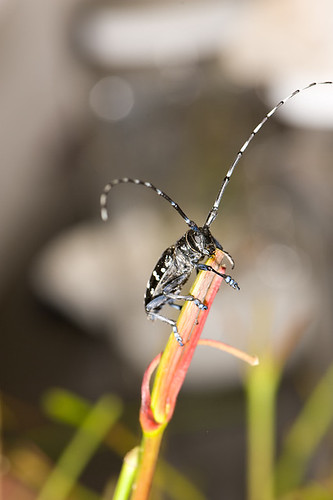USDA Blog Post:

An invasive ALB perched on a branch. August is "Tree Check Month" when adult ALB like this one can be easily spotted on or around hardwood trees. Photo by R. Anson Eaglin.
From the moment an Asian longhorned beetle (ALB) infests a tree, there is no cure. No amount of treatments will drive this deadly pest from the comfort of America’s heartwood, leaving thousands of trees dead and dying in the northeastern U.S. However, as bleak as this may sound, there is a way to stop this beetle, but we need your help. The American public could be one of the ALB’s greatest opponents, and in stopping the beetle you can help save trees.
USDA’s Animal and Plant Health Inspection Service (APHIS), the U.S. Forest Service, the Nature Conservancy, and American Forests held a joint news conference at the National Press Club on July 29, 2013 to urge the public to report signs of the invasive pest that threatens recreational areas, forests, and suburban and urban shade trees. These agencies have named August “Tree Check Month” in order to encourage the public to examine their trees for signs of ALB.
“The sooner we can find infested trees, the sooner we can save non-infested trees,” said Rhonda Santos, USDA-APHIS’s ALB Public Information Officer. “We’re asking the public to be aware of how to detect ALB infestations, to check their trees and report any suspicions.”
The ALB was first discovered in the U.S. in 1996, likely arriving unknowingly inside wood packing material from Asia. The insect has no known natural predators in the US. The beetle bores through the tissues that carry water and nutrients throughout the tree, starving and weakening the tree until it dies. Once a tree is infested, it must be removed.
Massachusetts, a stated heavily infested with ALB, has already lost 33,000 trees to the infestation around Worcester. Meanwhile, in Boston, only 6 infested trees have been found and removed to date due to an informed hospital employee’s careful observations of trees on the grounds. Had this report not been submitted, Boston’s trees may have met a Worcester fate.
Scott Pfister, USDA-APHIS’s Director of Pest Management, acknowledges that having the public’s support is a tremendous help in the effort to stop deadly infestations before they occur. “If we all work together, we stand a much better chance of eradicating this invasive insect,” Pfister said. “This August, please take ten minutes to check your community’s trees for signs of the ALB. You just might be saving thousands of trees down the road.”
Want to know how to check for ALB? Visit http://asianlonghornedbeetle.com/ for detection tips, and rules on preventing further spread of the ALB. If you see signs of ALB in your community, take a digital photo or capture a specimen and freeze it if possible. Then contact your state or county officials, submit a report through the ALB website above, or call APHIS’s ALB hotline at 1-866-702-9938.

Using binoculars can help residents check for signs of ALB high in the canopy of susceptible trees. Photo by R. Anson Eaglin.
No comments:
Post a Comment
Note: Only a member of this blog may post a comment.